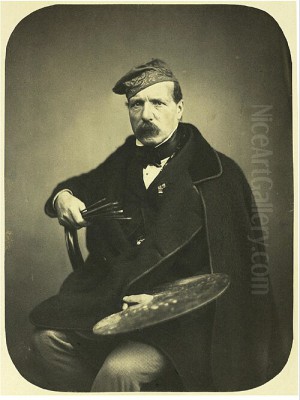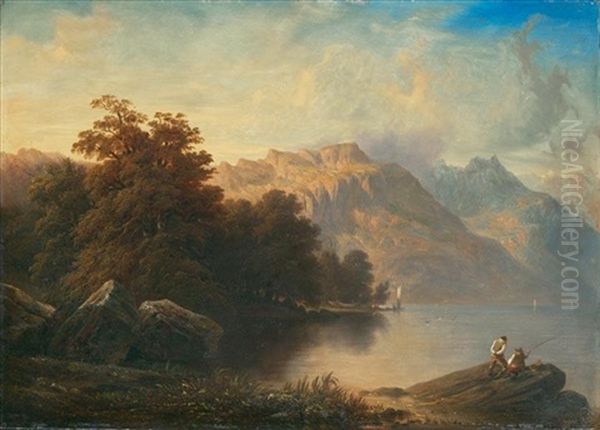
François Diday stands as a significant figure in the landscape of 19th-century Swiss art. Born in Geneva in 1802 and passing away in the same city in 1877, Diday dedicated his artistic career primarily to capturing the sublime beauty and rugged grandeur of the Swiss Alps and the serene expanse of Lake Geneva. His work, deeply rooted in the principles of Naturalism, is celebrated for its meticulous attention to detail, particularly in the rendering of geological formations, and for its ability to convey the powerful emotional impact of Alpine scenery. He became a cornerstone of the Geneva school of landscape painting, influencing subsequent generations of artists.
Early Life and Artistic Formation
Born into the vibrant cultural milieu of Geneva, François Diday showed an early inclination towards the arts. While details of his earliest training remain somewhat sparse, it is known that his formal artistic education took him beyond the borders of Switzerland. He traveled to Paris, the undisputed center of the European art world at the time, to hone his skills. This period likely exposed him to the prevailing academic standards as well as the burgeoning movements that were challenging artistic conventions.
Following his time in Paris, Diday embarked on a journey to Italy, a near-obligatory pilgrimage for landscape artists of his era. Italy offered not only the masterpieces of Renaissance and Baroque art but also the classical landscapes that had inspired painters for centuries, such as Claude Lorrain and Nicolas Poussin. The unique light, ancient ruins, and picturesque countryside of Italy undoubtedly left an impression on the young artist, broadening his visual vocabulary and technical repertoire before he returned to his native Switzerland, ready to apply his experiences to the landscapes he knew best.
Establishing a Vision: The Geneva Landscape

Upon returning to Geneva, Diday established himself as a painter focused intently on the natural world surrounding him. Lake Geneva (Lac Léman) and the nearby mountains, including the Salève, became frequent subjects. However, it was the High Alps that truly captured his imagination and would form the core of his artistic identity. He developed a reputation for his rigorous approach, likely involving sketching trips into the mountains to observe nature directly, followed by careful execution of larger canvases in his studio.
His dedication began to yield significant recognition. A pivotal moment came in 1837 with his painting Vue d’un lac (Lake View). Exhibited likely at the prestigious Paris Salon, the work garnered considerable acclaim, culminating in Diday being awarded the Cross of the Legion of Honour by King Louis-Philippe I of France. This accolade not only cemented his reputation in Switzerland but also brought him international attention, marking his arrival as a major figure in European landscape painting.
The Majesty of the Alps
Diday’s fascination with the Alps went beyond mere picturesque representation. His paintings often delve into the specific character of the mountains, capturing the textures of rock, the translucency of glacial ice, and the dramatic play of light and shadow across vast mountain faces. Works from his Rosenlaui series, depicting the valley and glacier near Meiringen, exemplify this deep engagement. These paintings are noted for their remarkable geological accuracy, suggesting Diday possessed a keen interest in the natural sciences that informed his artistic practice.
His large-scale 1844 painting, Landscape of Rosenlaui, the Wellhorn and the Wetterhorn, is a testament to his ambition and skill in rendering these imposing peaks. This particular work earned him a gold medal from the city of Bern, further solidifying his status within Switzerland. Diday's Alpine scenes often evoke the Romantic concept of the Sublime – the feeling of awe, wonder, and sometimes terror, experienced in the face of nature's overwhelming power and scale. He frequently included small human figures in his compositions, emphasizing the vastness of the landscape and humanity's place within it, a common trope in Romantic and Naturalistic landscape painting. His depictions of iconic peaks like the Mont Blanc contributed significantly to the visual culture surrounding the Alps during a period of growing tourism and scientific exploration.
Style: Naturalism Tinged with Romanticism
François Diday's artistic style is best characterized as a form of Naturalism infused with the emotional sensibility of Romanticism. His commitment to Naturalism is evident in the precise rendering of details – the careful delineation of rock strata, the accurate depiction of trees and foliage, and the convincing representation of water and ice. He observed the effects of light and atmosphere closely, capturing the clarity of mountain air or the drama of an approaching storm.
However, his work transcends simple topographical accuracy. There is a palpable Romantic spirit in his choice of subjects – often wild, untamed mountain scenery – and in the dramatic compositions and lighting he employed. He aimed to convey not just what the landscape looked like, but also the feelings it inspired. While contemporary French artists of the Barbizon School, such as Théodore Rousseau or Charles-François Daubigny, often focused on more intimate, pastoral scenes, Diday embraced the monumental scale of the Alps. His realism differed from the socially-charged Realism of Gustave Courbet, remaining focused on the power of nature itself.
A Teacher's Influence: The Geneva School
Beyond his own artistic output, François Diday played a crucial role as an educator, becoming a central figure in what is often referred to as the Geneva School of landscape painting. His most famous pupil was undoubtedly Alexandre Calame (1810-1864). Calame initially sought Diday's instruction around 1829, reportedly with the help of a patron named Diodati. Under Diday's guidance, Calame fully embraced Alpine subjects, developing a style that, while indebted to his master, achieved its own international renown, sometimes even surpassing Diday's fame during their lifetimes.
The relationship between Diday and Calame appears to have been foundational for the development of Swiss landscape painting in the 19th century. Another notable artist, Robert Zünd (1827-1909), also sought instruction in Geneva, studying with both Diday and Calame around 1848. This highlights Geneva's status as a significant center for landscape art education, largely thanks to the presence and influence of Diday and his prominent student. While perhaps not a formally organized "school," Diday's studio fostered a distinct approach to depicting the Swiss landscape.
Notable Compositions
Throughout his long career, Diday produced a considerable body of work. Several paintings stand out as representative of his style and thematic concerns. Mont Blanc and Lake Geneva Panorama captures the iconic view, showcasing his ability to handle vast distances and atmospheric perspective. La Grotte du Petit Salève (1868) likely highlights his interest in specific geological features and the interplay of light and shadow within a cave structure near Geneva.
The aforementioned Vue d’un lac (1837) was critical for launching his career. The large Alpine landscape featuring the Wellhorn and Wetterhorn mountains (1844) demonstrated his mastery of the high mountain subject and earned him official recognition in Bern. An interesting departure from his usual subject matter is the Interior Passage in the Colosseum, likely painted following his Italian travels. This work demonstrates his versatility and his sensitivity to architectural subjects and the dramatic potential of interior light, echoing the interests of artists like Hubert Robert or Giovanni Paolo Panini from earlier generations, but rendered with a 19th-century sensibility.
Diday in the Wider Art World
François Diday operated within a rich and complex European art scene. In Switzerland, his work can be seen as building upon the legacy of earlier Alpine painters like Caspar Wolf (1735-1783), while being contemporary with other significant Swiss artists such as the genre painter Albert Anker (1831-1910) and fellow Genevan Barthélemy Menn (1815-1893), though Menn's style evolved differently towards a more atmospheric approach. Diday's primary artistic dialogue, however, was arguably with his student Alexandre Calame and later followers like Robert Zünd.
His participation in the Paris Salon placed him in direct comparison with leading French artists. While distinct from the Barbizon painters like Jean-Baptiste-Camille Corot and Théodore Rousseau, he shared their commitment to landscape. He worked during the rise of Realism championed by Gustave Courbet and saw the beginnings of Impressionism, though his own style remained firmly rooted in detailed naturalistic observation. His recognition by King Louis-Philippe connects him to the official patronage systems of the July Monarchy. His Alpine subjects also resonated with a broader European interest in mountain scenery, seen in the work of German Romantics like Caspar David Friedrich (though Diday's style is less symbolic) and potentially finding echoes in the dramatic Alpine views of the British master J.M.W. Turner. Academic contemporaries in France whose work might have been exhibited alongside his include figures like Jean-Léon Gérôme, although their subject matter differed greatly.
Later Years and Enduring Legacy
François Diday continued to paint and exhibit throughout his life, remaining a respected figure in the Swiss art world. His dedication to the Alpine landscape never wavered, and he consistently produced works that celebrated the beauty and power of his native environment. His influence extended through his students and through the widespread appreciation of his paintings, which helped shape both Swiss and international perceptions of the Alps.
Upon his death in Geneva in 1877, François Diday bequeathed his property to the city. This final act underscored his connection to his birthplace and likely contributed to the preservation and public accessibility of his work and potentially supported the local art institutions. His legacy lies in his significant contribution to the genre of landscape painting, particularly his powerful and detailed depictions of the Alps. He successfully blended objective observation with a Romantic sensibility, creating images that were both topographically convincing and emotionally resonant.
Conclusion
François Diday remains a pivotal artist in the history of Swiss art. As a master of Alpine landscape painting, he captured the unique majesty of the mountains with unparalleled dedication and skill. His work reflects the confluence of Naturalism and Romanticism that characterized much of 19th-century landscape art, but with a specific focus on the geological and atmospheric realities of the Swiss environment. Through his paintings and his role as a teacher, particularly of Alexandre Calame, Diday profoundly shaped the course of landscape painting in Geneva and beyond, leaving behind a powerful visual record of the Alps that continues to inspire awe and admiration. He stands as a key chronicler of the natural world that defined so much of Switzerland's identity.